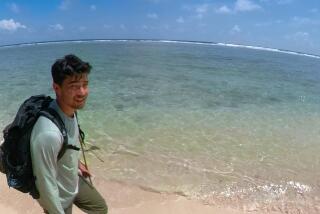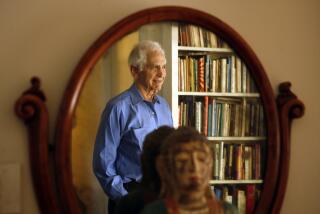Mao and Comrades Met U.S. at Dixie Mission
- Share via
I stared in astonishment at its 10,000 caves on my first visit in 1945 to the isolated Chinese communist capital of Yan’an, next to the Gobi Desert. My wonder grew as I spotted the Stars and Stripes fluttering from a flagpole of the U.S. Army Observer Group.
Popularly known as the Dixie Mission, this small encampment of officers and enlisted men is almost forgotten. But in its four years of existence, it set a record. It was the first official U.S. organization to establish contact with Communist Party Chairman Mao Tse-tung and his battle-scarred comrades 28 years before President Richard Nixon’s famous visit to Beijing in 1972.
Sixty years after the mission was installed in Yan’an, a dusty city near the Great Wall of China in the northern province of Sha’anxi, historians and diplomats debate whether it was a success or failure.
Its wartime instructions to rescue downed American fliers were successful: More than 100 were saved. But some critics thought that its diplomats and “red experts,” rather than military men, should have stayed on to take advantage of its unique contacts with Mao and his followers. Others believed that it would be a waste of time.
The mission wound up in 1947, and two years later, Mao’s army swept south to drive out the nationalist regime of Chiang Kai-shek and complete China’s communist revolution.
Despite the rocky history of U.S.-Chinese relations that followed, the Chinese government looks back on the Dixie Mission period with evident nostalgia. In 1978 and 1991, it invited the mission’s survivors and their families to Yan’an to relive their memories. It did so again last week with banquets and receptions in Beijing.
I got to Yan’an in November 1945 and stayed for seven months to report on the communist side of negotiations with the nationalists mediated by Gen. George C. Marshall, President Harry Truman’s emissary. Associated Press was the only foreign news organization to stay in Yan’an.
The Chinese had dug their caves in 1938 to house hospitals, universities, newspapers and training schools after Japanese air raids reduced the walled city to rubble. The Dixie Mission dug its own caves on arrival in 1944.
I occupied one of them, a dwelling like none I had ever known -- 8 feet by 10 -- light filtering in softly through glassless, paper-covered windows. The only bits of furniture were a table on which I installed my portable typewriter, a wooden chair, a wash basin and a bed -- planks set on saw horses.
Although the mattress was paper thin and the sand-stuffed pillow was rock-hard, I slept better than ever before in the 2,000-foot altitude and dry desert air.
The nearest toilet was 30 yards away, and a single charcoal brazier failed to dispel the chill winter winds. But I quickly learned to live with the cold after charcoal fumes knocked me out and I had to be revived with oxygen. The effects of the mission’s lard-laden food lasted longer -- I had acidosis for months.
Members of the mission and I dressed in padded clothes and showered in the makeshift bathhouse once a week, whether we needed it or not. But compared to the communists, reduced by the nationalist blockade to one patched and faded suit a year, we were squeaky clean.
The Cold War to come was already claiming political victims. Mission chief Col. Ivan D. Yeaton, a ramrod-straight New Englander and starchy conservative, told me that he was banished to Yan’an because as an assistant military attache in Moscow, he questioned the need for large amounts of American aid to the wartime Soviet Union. His liberal-thinking predecessor as mission chief, Col. Dave Barrett, antagonized the conservative U.S. ambassador, Patrick J. Hurley, and paid for it by failing to get his general’s star. Diplomats Jack Service and John Davies, who predicted Mao would triumph, were ignored by the State Department and pilloried in the 1950s by Sen. Joe McCarthy.
Marshall’s name would later become almost synonymous with the reconstruction of post-World War II Europe. In China, the craggy-faced general appeared successful in persuading the nationalists and communists to form a working coalition government. In a few weeks, he brought about a seemingly unattainable cease-fire and months later, in December 1946, stopped overnight in Yan’an en route to report his success to Truman.
Mao and his lieutenants shucked their shabby clothes and sneakers, and met him at the airport wearing newly tailored woolen suits and shoes. Mao and Marshall rode into town in a truck provided by the mission.
After agreeing on broadening the cease-fire effort, they drank toasts of fiery liquor from porcelain tea cups. But Chiang Kai-shek, believing that his army was stronger than Mao’s, refused to honor a cease-fire and was ultimately defeated and exiled to Taiwan.
Throughout their stay, very few of the Dixie mission team got to know what the otherwise friendly communists thought. Their hosts took them on pheasant-hunting trips, and Mao and other leaders visited the compound to see American movies, but political discussion always was taboo.
Yeaton apparently expected this also to apply to me. When Zhu De, the amiable commander-in-chief, appeared at dinner one holiday, I asked his reaction to a nationalist initiative. He answered in detail, but Yeaton was clearly annoyed and made it clear to me that in future meetings with the leading communists, I was to be seen, not heard.
Some say the confusion over how close the mission should get to the communists spelled a golden opportunity forever lost. No one listened to those who predicted a communist victory.
In March 1947, 15 months after I got to Yan’an, with nationalist forces closing in, the mission turned over its vehicles to the communists and both left. When I asked for my final bill for food and lodging, Yeaton said Mao had offered to pick up the tab.
McCarthy and the anti-communist committees were years away, but I prudently decided that Associated Press would pay instead.
John Roderick reported from China for Associated Press from 1945 to the 1949 communist takeover, and from the 1972 reopening of China to 1984.
More to Read
Sign up for Essential California
The most important California stories and recommendations in your inbox every morning.
You may occasionally receive promotional content from the Los Angeles Times.









